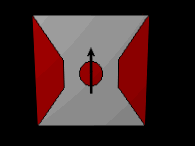
Materials Research Science and Engineering Center: Faculty Publications
Document Type
Article
Date of this Version
11-5-2004
Abstract
The effect of disorder on the ferromagnetic transition is investigated in mechanically milled GdAl2. GdAl2is a ferromagnet when crystalline and a spin glass when amorphous. Mechanical milling progressively disorders the alloy, allowing observation of the change from ferromagnetic to a disordered magnetic state. X-ray diffraction and pair-distribution-function analysis are used to determine the grain size, lattice parameter, and mean-squared atomic displacements. The magnetization as a function of temperature is described by a Gaussian distribution of Curie temperatures. The mean Curie temperature decreases with decreasing lattice parameter, where lattice parameter serves as a measure of defect concentration. Two different rates of change with lattice parameter are observed: the first, slower rate occurs while grain size is changing, and the grain size is constant in the second regime. The breadth of the Curie temperature distribution is linear with lattice parameter. Milled and annealed GdAl2 shows that the mean Curie temperature has the same general dependence on lattice parameter as milled, but unannealed GdAl2, while the breadth of the Curie temperature distribution is different in annealed samples compared to the unannealed materials.


Comments
Published in Physical Review B, 70, 184407 (1 November 2004)
Copyright © 2004 The American Physical Society. Used by permission
URL: http://link.aps.org/abstract/PRB/v70/e184407
doi:10.1103/PhysRevB.70.184407